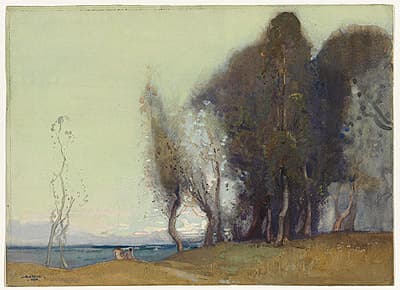Sydney
LONG
Australia
1871
–
London
1955
England, Europe 1910-21; Australia 1921- 22; England 1922-25; Australia 1925-52; England from 1952
30.8 (h) x 42.6 (w) cm
signed and dated ‘SID LONG/ 1918’ lower left Mildura Arts Centre, Hilda Elliott Bequest 1970
A dawn possesses all those evocative qualities that make Long’s work so unique. Though the landscape setting for the rising sun is generic, the flat expanse with its vast skyscape and the towering gums evokes Australia. Diminutive nude figures, humans or bush nymphs, sit at the edge of the water, either a river or the coast. The sinuous tree trunks twist, in classic Art Nouveau patterning, vertiginously towards the sky. The delicate, lace-like foliage of the gums is typically blurred and out of focus, so that the trees melt into each other while standing outlined against a low horizon. The work reflects the artist’s debt to Camille Corot.
A delicate mist appears to hang suspended among the trees enhancing the poetic quality of mystery and other-worldliness. Long has elaborately interwoven elements of naturalistic painting with the artifice of an ornate stage-like setting, in a blending of the art of Corot and Antoine Watteau. The mood of nostalgia also seems to derive from Long’s re-working of old motifs. There is a sense of emptiness, even loneliness, in this landscape in which the figures are dwarfed by the scale of their setting. When Long painted this image, his life was difficult: he was poor
and the world was at war.
A dawn was painted in England and has strong similarities to Long’s Pastoral softground (cat 69). It was possibly first exhibited in 1921 at the exhibition,
The water-colours and etchings of Sydney Long, ARE, Decoration Galleries, Melbourne,
15–26 August (10, as ‘Pastoral, morning’).
It was formerly known as ‘Australian idyll’,
but retitled on the basis of a label on the reverse, ‘A dawn’.
Paul McIntyre
A dawn possesses all those evocative qualities that make Long’s work so unique. Though the landscape setting for the rising sun is generic, the flat expanse with its vast skyscape and the towering gums evokes Australia. Diminutive nude figures, humans or bush nymphs, sit at the edge of the water, either a river or the coast. The sinuous tree trunks twist, in classic Art Nouveau patterning, vertiginously towards the sky. The delicate, lace-like foliage of the gums is typically blurred and out of focus, so that the trees melt into each other while standing outlined against a low horizon. The work reflects the artist’s debt to Camille Corot.
A delicate mist appears to hang suspended among the trees enhancing the poetic quality of mystery and other-worldliness. Long has elaborately interwoven elements of naturalistic painting with the artifice of an ornate stage-like setting, in a blending of the art of Corot and Antoine Watteau. The mood of nostalgia also seems to derive from Long’s re-working of old motifs. There is a sense of emptiness, even loneliness, in this landscape in which the figures are dwarfed by the scale of their setting. When Long painted this image, his life was difficult: he was poor
and the world was at war.
A dawn was painted in England and has strong similarities to Long’s Pastoral softground (cat 69). It was possibly first exhibited in 1921 at the exhibition,
The water-colours and etchings of Sydney Long, ARE, Decoration Galleries, Melbourne,
15–26 August (10, as ‘Pastoral, morning’).
It was formerly known as ‘Australian idyll’,
but retitled on the basis of a label on the reverse, ‘A dawn’.
Paul McIntyre
A dawn possesses all those evocative qualities that make Long’s work so unique. Though the landscape setting for the rising sun is generic, the flat expanse with its vast skyscape and the towering gums evokes Australia. Diminutive nude figures, humans or bush nymphs, sit at the edge of the water, either a river or the coast. The sinuous tree trunks twist, in classic Art Nouveau patterning, vertiginously towards the sky. The delicate, lace-like foliage of the gums is typically blurred and out of focus, so that the trees melt into each other while standing outlined against a low horizon. The work reflects the artist’s debt to Camille Corot.
A delicate mist appears to hang suspended among the trees enhancing the poetic quality of mystery and other-worldliness. Long has elaborately interwoven elements of naturalistic painting with the artifice of an ornate stage-like setting, in a blending of the art of Corot and Antoine Watteau. The mood of nostalgia also seems to derive from Long’s re-working of old motifs. There is a sense of emptiness, even loneliness, in this landscape in which the figures are dwarfed by the scale of their setting. When Long painted this image, his life was difficult: he was poor
and the world was at war.
A dawn was painted in England and has strong similarities to Long’s Pastoral softground (cat 69). It was possibly first exhibited in 1921 at the exhibition,
The water-colours and etchings of Sydney Long, ARE, Decoration Galleries, Melbourne,
15–26 August (10, as ‘Pastoral, morning’).
It was formerly known as ‘Australian idyll’,
but retitled on the basis of a label on the reverse, ‘A dawn’.
Paul McIntyre

